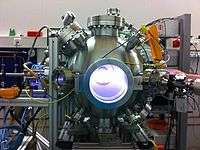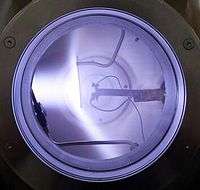Nano-PSI


Nano-PSI is a plasma device at the FOM - Dutch Institute For Fundamental Energy Research (FOM-DIFFER). It is used for experimental research at the junction of plasma physics and materials science. 'PSI' stands for Plasma Surface Interactions, while 'nano' has been chosen to stress the mission of the device to synthesize various nanostructures. Nano-PSI is the newest addition to the family of plasma generators at DIFFER, that also hosts the Magnum-PSI and Pilot-PSI linear devices.
The plasma is created by a Cascaded Arc Plasma Source,[1] which exhausts into the spherical vacuum vessel. Gases such as Helium, Nitrogen, Argon, Xenon can be used to create plasma. Samples are mounted in direct view of the plasma. The plasma species interact with the atoms of the sample, leading to surface modifications. In general this process is called plasma processing.
A Langmuir probe can be used to determine the plasma parameters, such as density and temperature. The substrate holder can be electrically biased to attract desired quantities of ions or electrons. Besides, it is possible to heat or cool the sample to a given temperature during operation. Large transient heat fluxes can be created when the plasma source is coupled to a capacitor bank.
See also
- Chemical vapor deposition
- Pulsed laser deposition
- Gas discharge plasmas and their applications.[2]
- Semiconductor manufacturing; Plasma-enhanced chemical vapor deposition
- National Spherical Torus Experiment in nuclear fusion
References
- ↑ G.M.W. Kroesen; D.C. Schram & J.C.M. de Haas (1990). "Description of cascade arc plasma" (PDF). Plasma Chemistry and Plasma Processing, 10(4):531–551, 1990.
- ↑ A. Bogaerts; E. Neyts; R. Gijbels; J. van der Mullen (2002). "Gas discharge plasmas and their applications" (PDF). Spectrochimica Acta Part B 57:609-658.
Further reading
- Nanostructuring of molybdenum and tungsten surfaces by low-energy helium ions (Journal of Vacuum Science & Technology A; Volume 30;Issue 4)
- Tungsten fuzz growth
- Nanostructured MoS2 and WS2 for the Solar Production of Hydrogen
- The effects of helium on deuterium retention in tungsten under simultaneous irradiation